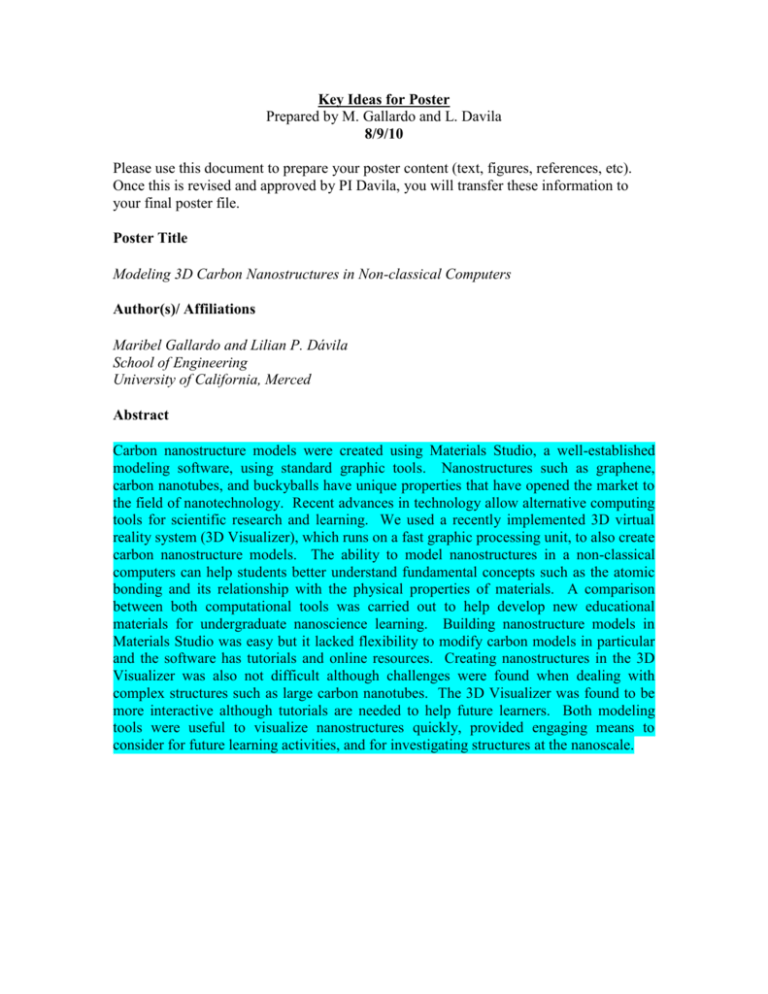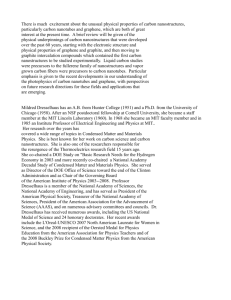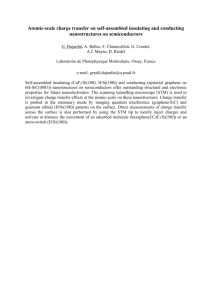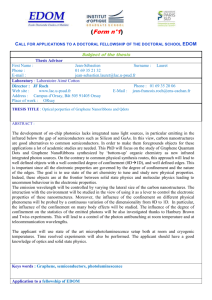PreFinal-Prep for Poster-COINS-Maribel-81010
advertisement

Key Ideas for Poster Prepared by M. Gallardo and L. Davila 8/9/10 Please use this document to prepare your poster content (text, figures, references, etc). Once this is revised and approved by PI Davila, you will transfer these information to your final poster file. Poster Title Modeling 3D Carbon Nanostructures in Non-classical Computers Author(s)/ Affiliations Maribel Gallardo and Lilian P. Dávila School of Engineering University of California, Merced Abstract Carbon nanostructure models were created using Materials Studio, a well-established modeling software, using standard graphic tools. Nanostructures such as graphene, carbon nanotubes, and buckyballs have unique properties that have opened the market to the field of nanotechnology. Recent advances in technology allow alternative computing tools for scientific research and learning. We used a recently implemented 3D virtual reality system (3D Visualizer), which runs on a fast graphic processing unit, to also create carbon nanostructure models. The ability to model nanostructures in a non-classical computers can help students better understand fundamental concepts such as the atomic bonding and its relationship with the physical properties of materials. A comparison between both computational tools was carried out to help develop new educational materials for undergraduate nanoscience learning. Building nanostructure models in Materials Studio was easy but it lacked flexibility to modify carbon models in particular and the software has tutorials and online resources. Creating nanostructures in the 3D Visualizer was also not difficult although challenges were found when dealing with complex structures such as large carbon nanotubes. The 3D Visualizer was found to be more interactive although tutorials are needed to help future learners. Both modeling tools were useful to visualize nanostructures quickly, provided engaging means to consider for future learning activities, and for investigating structures at the nanoscale. Introduction Nanomaterials is a field which takes a material science-base approach to nanotechnology, it involves the study of materials with morphological features at the nanoscale [5]. Nanomaterials include organics, metals, polymers, semiconductors, ceramics, glasses, minerals, and composites at a small scale [1]. The uses for nanomaterials range from computer chips, light and electron emitting devices, structural materials, medical implants, energy conservation and storage [1]. Many challenges remain including the development of more sophisticated and specialized materials, as well as fixing renewable resources [3]. The discovery of a graphene structure (layers of hexagonally arranged C atoms within the layers, each C atom is bonding to three coplanar neighboring atoms by covalent bonds) has lead to a new field of possibilities in nanotechnology [3]. A graphene sheet of 1-2 nm can be extracted and rolled into a carbon nanotube to obtain an incredible strength; stronger than diamond [4]. Graphene has excellent lubrication properties due the van der waals bonding. They are often used in furnaces, electrodes for arc welding, chemical and biological sensors, and batteries [2,5], as well as in transistors for electronic and radio frequency devices [6]. The first discovered fullerene, the buckminsterfullerene, is composed of a hollow spherical cluster of 60 C atoms; each molecule is bonded together to form hexagons and pentagons [4]. The result of this carbon arrangement is an extremely strong molecule known as a Buckyball due to their van der Waals bonding. The applications range from medical uses including binding specific antibiotics to a structure to target resistant bacteria [5]. Buckyballs are also used as catalysts they have the ability to accept and to transfer hydrogen atoms [8]. In vehicles they have the capability of proton exchange membranes for fuel cells [8]. Fullerenes are also powerful antioxidants reacting readily at high rate with free radicals that damage tissue [8]. They have the potential use for photo-detector for x-rays, telecommunications and as lubricants [7]. A carbon nanotube (CNT) is a structure of graphite rolled into a tube with both ends capped with C60 fullerene hemisphere [4]. The uses of carbon nanotubes include Field Emission-based panel displays, novel semiconducting and hydrogen storage devices, structural reinforcement agents, and chemical sensors [1]. There are two main types of CNTs: a) Single Wall Nanotubes (SWNTs) with a diameter close to 1nm that can be many times longer and b) Multiwall Carbon Nanotubes (MWNT) made of multiple concentric graphite tubes [5]. There are three ways in which a graphene sheet can be rolled into a tube: i) armchair, ii) zigzag (have high degree of symmetry) and iii) chiral. The term armchair and zigzag refer to the arrangement of hexagons around the circumference. The chiral class can exist in two mirror-related forms [9]. The synthesis methods that produce these structures include: arch discharge, laser ablation, high pressure carbon monoxide, and the most commonly used chemical vapor deposition [5]. Carbon nanotubes are strong, tough, and stiff; resulting from covalent bonding sp2 bonds [5] hence have high tensile strength 50-200GPa, thus are the strongest materials known. Depending on the chiral indices, CNTs can behave like metals or semiconductors [1]. The potentials applications of CNTs include clothing, sports gear to combat jackets and space elevators [5]. Nanotube-based transistors have been made to operate at room temperature and are capable of digital switching using a single atom [5]. Computational molecular modeling approaches have emerged as important tools that can be used to predict atomic structure, vibrational frequencies, binding energies and many other physical properties at the nanoscale [1]. The objective of this project is to create 3D models of carbon nanostructures in non-classical computers for developing alternative educational materials for undergraduate nanoscience learning. Methods Our project involved the use of a commercial modeling software (Materials Studio, version 4.2 from Accelrys Inc.) and a 3D virtual reality system (3D Visualizer) recently implemented at our research laboratory. This software provides a range of functions for molecule bonding and simulations of materials. The tasks involved modeling several graphene sheets, carbon nanotubes, and buckyballs with specific dimensions in both Materials Studio and the new 3D Visualizer system. The building modeling process was compared in both systems to develop educational materials for future nanoscience learning. Also, quantitative (measurements) and qualitative data were obtained to measure the usefulness of both systems. The general procedure to create carbon-based nanostructures using Materials Studio is summarized next. For Graphene Models: a) Select a 3D workspace and create a hexagon structure (carbon ring of size 6) using the Sketch tool, b) Connect additional hexagonal units to previous carbon ring to form a one-dimensional sheet representing a graphene structure (e.g. 6x6). For CNT Models: a) Build any carbon nanotube (e.g. single wall nanotube) using the Build Nanotube tool and entering desired m and n parameters to control the chirality and diameter of the desired nanotube. For Buckyball Models: a) Import built-in models (e.g. C60) or alternatively build buckyballs manually, which is often a time-consuming process. In all cases, structural measurements of bond distances and bond angles were performed. Creating nanostructures in the 3D Visualizer involved different steps using built-in software. The Nanotech Construction Kit (NCK) software enables the user to construct 3D virtual models using a Wii remote device to control the building process. For Graphene Models: a) Create a built-in basic building block unit (triangular prism) using the Wii remote. Each triangular prism unit represents a C atom with simple atomic forces at each corner that can either repel or attract other similar units, b) Locate the triangular unit in 3D working space using the Trigger tool in the Wii remote and add additional units to the one previously created, and c) Repeat steps until a onedimensional sheet is created (e.g. 3x3). For CNT Models: a) Carefully roll a graphene model (e.g. 6x6) into a hollow tube using the Wii remote. This step involved using the simple atomic forces to control the rolling process. For Buckyball Models: a) Create pentagon and hexagon rings using the triangular units, b) Connect pentagons to hexagons until forming a buckyball, and c) Repeat process with extra hexagonal and pentagonal units for larger buckyballs. Structural measurements of bond distances and bond angles were also performed. The above steps are illustrated in the flowchart shown in Figure 1. Materials Studio 3D VR System Start Start Create Graphene Sheets Create Carbon Nanotubes Setup 3D VR system Using NCK/Wii remote Create Graphene Sheets Create Buckyballs Build Carbon Nanotubes Analyze Structures Build Buckyballs End Analyze Structures End (a) (b) Figure 1. Flowchart showing main steps in modeling processes using a) Materials Studio molecular modeling software and b) the recently installed 3D Visualizer system. Results Table A. Carbon nanostructures constructed using a standard modeling software (Materials Studio) and a 3D virtual system (3D Visualizer) for materials science research. Carbon Materials Studio 3D VR System Nanostructure Model Model Graphene (3x3) Figure 1a. Graphene Sheet 3x3 in Materials Studio Figure 1b. Graphene Sheet 3x3 in 3D Visualizer Graphene (6x6) Figure 2a. Graphene Sheet 6x6 in Materials Studio Figure 2b. Graphene Sheet 6x6 in 3D Visualizer CNT (n=3, m=0) N/A Figure 3a. Carbon Nanotube 3x3 in Materials Studio CNT (n=6, m=0) Figure 4a. Carbon Nanotube 6x6 in Materials Studio Figure 4b. Carbon Nanotube 6x6 in 3D Visualizer Buckyball (C60) Figure 5a. Buckyball C60 in Materials Studio Figure 5b. Buckyball C60 in 3D Visualizer Buckyball (C70/C180) Figure 6a. BuckyBall C70 in Materials Studio Figure 6b. Buckyball C180 in 3D Visualizer Discussion/Conclusion Materials Studio provided the user with the basic tools to construct nanoscale structures and the capability of importing structures from the library to analyze them. The program however limited the user from modifying some nanostructures, such as the buckyballs. It was also challenging to construct more complex structures. The 3D Visualizer on the other hand provided an interactive interface to construct carbon-based structures using a Wii remote rather quickly. This virtual system challenged the user’s ability to control the building of structures and it had a moderate learning curve for those users without prior experience with modern devices. Materials Studio was easy to learn, got more difficult to modify specific structures such as buckyballs, and it limited the users’ motivation to construct nanostructures because of limited tutorials on the subject. The 3D Visualizer was also easy to use, got more challenging to build more complex structures, provided the user with motivation to learn about structures due to the 3D visual and depth capabilities, and it was more interactive. Both modeling tools were useful to visualize structures rather fastly, provided engaging means to consider for future learning, and has potential for future research of structures at the nanoscale upon expansion to more realistic atomic forces and computer simulations. In both systems the user can create nanostructures and analyze them in three dimensions, with the capability of rotating and measuring atomic distances and angles. The main difference is that in Materials Studio the user interacts with a model via standard 3D graphics, while in the 3D Visualizer the user interacts with a 3D virtual model. Moreover, in Materials Studio models each sphere represents a C atom position and each stick represents a bond between C atoms. In the 3D Visualizer, the triangular units represent the C atoms and the bonds are represented by the corners of the triangular units. To improve future projects for undergraduate learning, it would be useful if Materials Studio had the capability to modify all built-in structures in its library and update their tutorials. In the 3D Visualizer, adding flexibility to the construction process (e.g. undo/redo button) will help the user more easily construct nanostructures. Also, indicating the attractive (+) and repelling (-) forces in the triangle units along with easy to comprehend tutorials will help the user build more readily nanostructures. Materials Studio and the 3D Visualizer allow one to learn how carbon nanostructures are bonded. The 3D Visualizer goes a step further by mimicking atomic forces of C atoms as a nanostructure is formed, allowing the user “feel” how strong a bond is or how difficult is to break one. References 1) J.-R. Hill, L. Subramanian, and A. Maiti. Molecular Modeling Techniques in Material Sciences. Boca Raton, FL, Taylor & Francis, 2005. 2) N.P. Guisinger and M.S. Arnold. Beyond Silicon: Carbon-Based Nanotechnology 35.4 (2010): 273-76. 3) M.J. Schulz, A. Kelkar, and M.J. Sundaresan. Nanoengineering of Structural, Functional, and Smart Materials. Boca Raton, FL, CRC/Taylor & Francis, 2006. 4) W.D. Callister. Materials Science and Engineering: an Introduction. New York, J. Wiley, 2007. 5) "Carbon Nanotube." Wikipedia, the Free Encyclopedia. Web. 29 July 2010. http://en.wikipedia.org/wiki/Carbon_nanotube. 6) F. Schwierz. "Graphene Transistors." Nature Nanotechnology 5 (2010): 487-496. 7) Cientifica, comp. "Fullereness Technology White Papers." Cientifica (2003): 1-12. Web. 12 July 2010. http://www.clubofamsterdam.com/contentarticles/01%20Nanotechnology/Fullerenes.pdf. 8) "Nano-C: Fullerenes: Applications." Nano-C: Fullerenes, Derivatives and Carbon Nanotubes. Nano-C, 2008. Web. 29 July 2010. http://www.nano-c.com/fullereneapp.html. 9) "Carbon Nanotubes." University of Reading Personal Web Pages. 20 Apr. 2010. Web. 07 Aug. 2010. http://www.personal.reading.ac.uk/~scsharip/tubes.htm. Avouris, Phaedon, and Richard Martel. "Progress in Carbon Nantube Electronics and Photonics." Beyond Silicon: Carbon-Based Nanotechnology 35.4 (2010): 306-13. Fuhrer, Michael S., Chun Ning Lau, and Allan H. MacDonald. "Graphene: Materially Better Carbon." Beyond Silicon: Carbon-Based Nanotechnology 35.4 (2010): 289-95.






